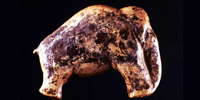Lonetal Sites, including Aurignacian sites in the Swabian Alb near the city of Ulm
This page is based on a report and photographs kindly sent to me by Michael Hess.
Important areas of ice age art occurred near Ulm (Germany), in the Schwaebische Alb (Swabian Alb), in the valleys of the Ach and Blau river near Blaubeuren (48°24'25.03"N, 09°47'02.67"E) and the Lonetal (48°32'58.27"N, 10°10'16.09"E), where the famous lion/human figure was found in the Hohlenstein-Stadel cave.
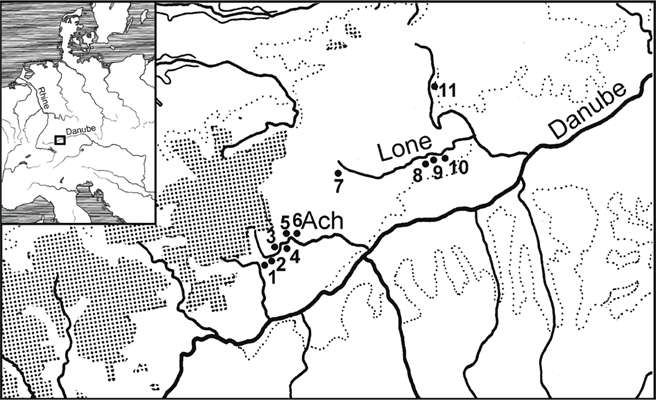
Map showing the major Middle Paleolithic and Aurignacian sites in the Swabian Jura.
1: Kogelstein;
2: Hohle Fels;
3: Sirgenstein;
4: Geißenklösterle;
5: Brillenhöhle;
6: Große Grotte;
7: Haldenstein;
8: Bockstein (Bockstein-Höhle, Bocksteinloch, Bocksteinschmiede, and
Bockstein-Törle);
9: Hohlenstein (Stadel and Bärenhöhle);
10: Vogelherd;
11: Heidenschmiede
(note that the Ach is mislabelled on this map, it is a tributary of the Blau, and should over most of its length shown here, especially as it approaches the Danube, be labelled as the Blau - Don )
Photo: Conard et al. 2011
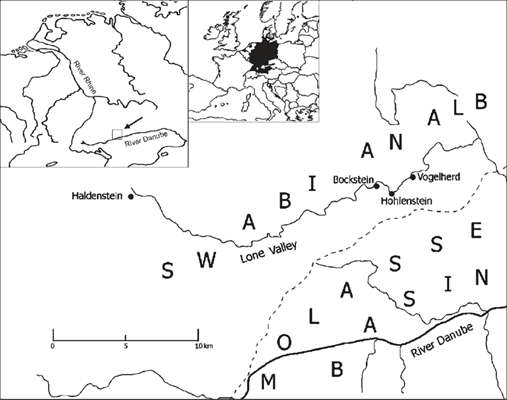
Map showing
• Haldenstein
• Bockstein (Bockstein-Höhle, Bocksteinloch, Bocksteinschmiede, and Bockstein-Törle)
• Hohlenstein (Stadel and Bärenhöhle)
• Vogelherd.
Photo: Krönneck et al. (2004)

Map showing
• Bockstein
• Hohlenstein
• Vogelherd.
It is 1.4 Km in a direct line from Bockstein to Hohlenstein, and 2 Km in a direct line from Hohlenstein to Vogelherd.
Photo: Google Earth
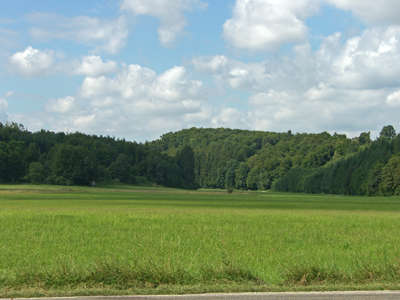
The crossing of the L 168 (country road) through the Lonetal near Bissingen (near the A7 exit). The view goes to the West along the Lone valley. The Vogelherd cave and find spot is about 200 metres to the left. The Hohlenstein cave - find spot of the Lion man - is about 2 km down the valley, see the Google Earth image above.
Photo and text: Michael Hess
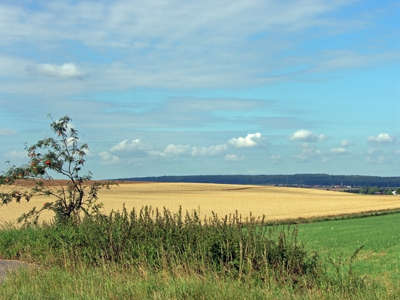
Michael writes:
Plains north of Ulm close to the Lone valley, view to the West.
During the Lower Palaeolithic Homo heidelbergensis (~ 600 000 BP) is known to have lived not far away. Remains were found in 1907 in the village of Mauer near Heidelberg, 200 Km from Ulm.
Homo steinheimensis (1933, Steinheim a. d. Murr), the link between Homo heidelbergensis and Homo neanderthaliensis , lived around 250 000 BP.
Photo and text: Michael Hess
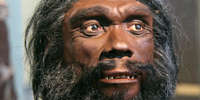 The first fossil discovery of Homo heidelbergensis was made on October 21, 1907, and came from Mauer where the workman Daniel Hartmann spotted a jaw in a sandpit. The jaw (Mauer 1) was in good condition except for the missing premolar teeth, which were eventually found near the jaw. The workman gave it to Professor Otto Schoetensack from the University of Heidelberg, who identified and named the fossil. The next Homo heidelbergensis remains were found in Steinheim an der Murr, Germany (the Steinheim Skull, 350 000 BP); Arago, France (Arago 21); Petralona, Greece; and Ciampate del Diavolo, Italy.
The first fossil discovery of Homo heidelbergensis was made on October 21, 1907, and came from Mauer where the workman Daniel Hartmann spotted a jaw in a sandpit. The jaw (Mauer 1) was in good condition except for the missing premolar teeth, which were eventually found near the jaw. The workman gave it to Professor Otto Schoetensack from the University of Heidelberg, who identified and named the fossil. The next Homo heidelbergensis remains were found in Steinheim an der Murr, Germany (the Steinheim Skull, 350 000 BP); Arago, France (Arago 21); Petralona, Greece; and Ciampate del Diavolo, Italy.
Due to the different glacial periods Mindel (460 000-400 000 BP), Riss (350 000-120 000 BP), and Würm (115 000-10 000 BP) there was no continuous inhabitation possible and an average population of about 1 000 hominids is estimated for the Middle Palaeolithic. The first appearance of Neanderthal Man in southern Germany (Böckingen near Heilbronn), occurred ~100 000 years BP and their presence was demonstrated from stone tools found in the area.
The valley (Lonetal) cutting through the plains allowed for a rich fauna and attracted Neanderthal people during the Middle Palaeolithic as early as 70 000 years ago (Bockstein cave, Lone valley), who hunted wooly rhinoceros, wooly mammoths, reindeer and horses. The Cro Magnon people finally arrived about 40 000 years BP or even earlier – with a fully developed Aurignacian (!)
Text above: Michael Hess

The Lone valley today looks much different from palaeolithic days when there was a tundra during the glacial periods of Günz (600 000 - 800 000 BP), Mindel (460 000 - 400 000 BP), Riss (350 000 - 120 000 BP) and Würm (115 000 - 10 000) and probably open steppe even with mixed forests from time to time during the interglacials, the last one was the short Eem interglacial (we are presently living in the next interglacial). Right now, the slopes of the valley are covered with a dense forest so that in particular the Bockstein and the Hohlenstein/Bärenhöhle can hardly be recognised from the valley in summer. The former flood plain is covered with grass and is hardly flooded any more since the ground water level went down significantly in recent years, so that the Lone only very rarely can be experienced as a water-bearing creek. The banks of the streambed are covered with Phalaris arundinacea, reed canarygrass.
This photograph is of the Lone valley near Bockstein cave looking East. The (dry) streambed is to the right near the edge of the woods. There are a number of archeologically important sites:
• The Fohlenhaus caves, a popular picnic (BBQ) site these days with ancient traces of human occupation.
• The Bockstein cave, with evidence of neolithic and mesolithic occupation but - most important - Mousterien findings dating back 50 000 to 70 000 BP, the oldest evidence of Homo neanderthalensis in Southern Germany. The cave is about 25 metres above the valley level and opens to the west. The site consists of three shelters, the ‘Höhle’ (= cave), the ‘Loch’ (= hole, opening), and the Grotte (= grotto), Figures 6-12.
Photo and text: Michael Hess

Information board at the Bockstein Cave. On the right of the table archaeological scale is shown. After climbing the stairs (visitors should take care, the stairs can be slippery, and the slope is steep) one reaches the forecourt surrounded by a dense forest.
The text reads:
Bockstein is one of the most interesting and diverse of the Paleolithic sites in Baden-Wurttemberg.
This is especially true for the middle Stone Age, the Middle Palaeolithic and especially the Aurignacian, for which it is of paramount importance.
Photo and text: Michael Hess 2012
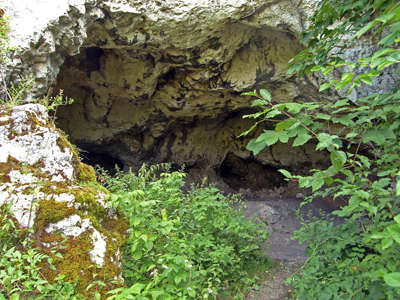
Forecourt and main entrance to the Bockstein cave. The 'Törle' (little gate) is to the left, out of frame.
Bocksteinhöhle
This site is situated on a steep slope in the Lone Valley and made up of one primary chamber. Other layers with archaeological material
were found in front of the cave and on the slope. The cave was excavated by Ludwig Bürger and Friedrich Losch in 1881 and 1883–84 and cultural layers with Mesolithic and Palaeolithic artefacts were found (Bürger,1892, Wehrberger 2000). Only a fauna species list is available (Lehmann 1960) and much of the material itself was lost.
(Krönneck et al. 2004)
Photo: Michael Hess 2012
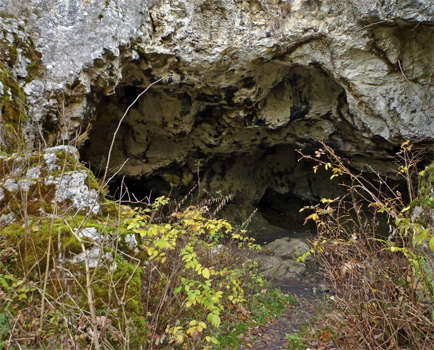

Bocksteinhöhle
Photo (left): Franzfoto
Permission: GNU Free Documentation License, Version 1.2
Photo (right): Wegerer, via Panoramio

Bockstein cave, 'Törle' ( small gate) from inside the cave.
Bocksteintörle, the Törle, former entrance of Bocksteinhöhle, was excavated by Robert Wetzel from 1953–56 at the same time as Bocksteinschmiede. The site itself is small but rich assemblages from the Middle Palaeolithic and Aurignacian were preserved (Wetzel, 1958, Wetzel & Bosinski, 1969, ) Only a species list of faunal remains is available (Wetzel, 1954)
Photo: Michael Hess 2012
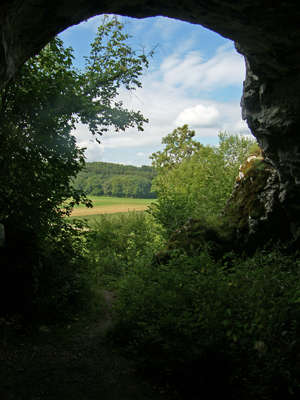
View out of the cave to the west.
Photo and text: Michael Hess 2012

Bocksteinloch.
Photo: Michael Hess 2012
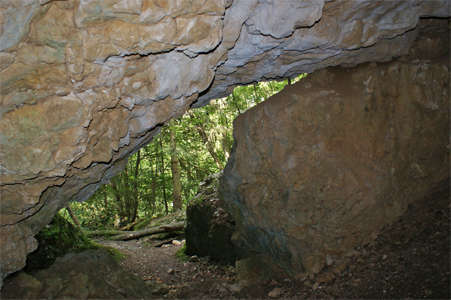
Bocksteinloch
Photo: Daniel Froschauer via Panoramio
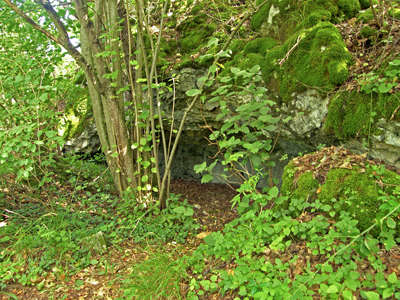
Bocksteingrotte.
Photo: Michael Hess 2012
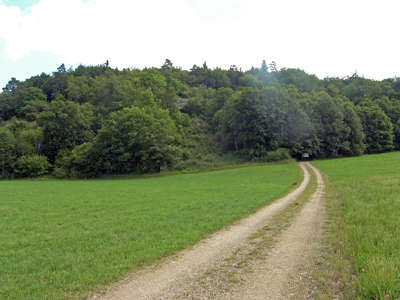
Bockstein, looking back to the east. The cave is close to the middle of the picture in the small, grey clearing.
Photo and text: Michael Hess 2012
Text below from:
https://www.nespos.org/display/PublicNesposSpace/Bocksteinschmiede-Bocksteinloch+-+excavation+1932-1935
Bocksteinschmiede and Bocksteinloch are excavated completely and altogether during the campaign between 1932 and 1935. The Bocksteinloch (Bockstein Hole) is a little cave of about 8 metre depth. The Bocksteinschmiede (Bockstein Smiths) is the forecourt of that cave. In the direction of the slope the forecourt (Bocksteinschmiede) is delimited by a small cliff, called the 'bastion'. The stratigraphical ensembles from Bocksteinloch and Bocksteinschmiede are not identical. Both stratigraphies are geared together but the Bocksteinschmiede have revealed more layers.
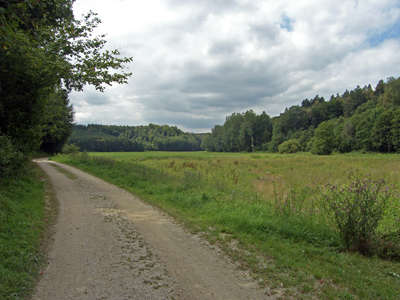
On the way from Vogelherd to Hohlenstein, westward through the Lonetal.
Photo and text: Michael Hess 2012
Hohlenstein-Stadel, Lonetal valley
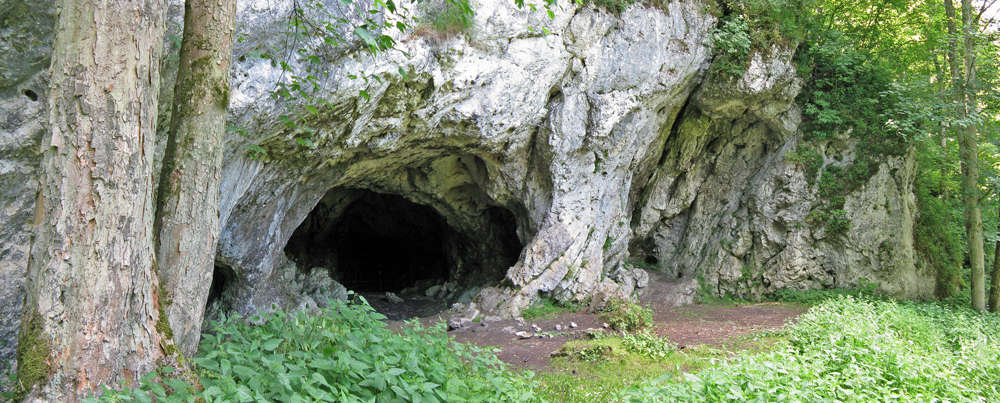
Cave Hohlenstein-Stadel, Lonetal valley, southern Germany.
Photo: Silosarg, 2008.06.21
Location: 48°32' 58.00"N, 10°10'22.00"E
Permission: Creative Commons Attribution-Share Alike 3.0 Unported license
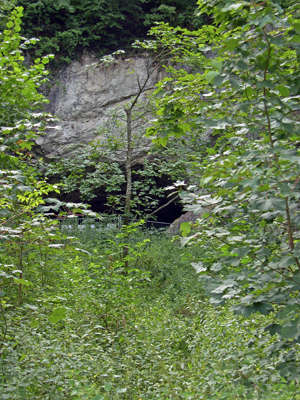
Entrance of Hohlenstein Stadel in the limestone cliff, seen from the level of the valley.
Photo and text: Michael Hess 2012
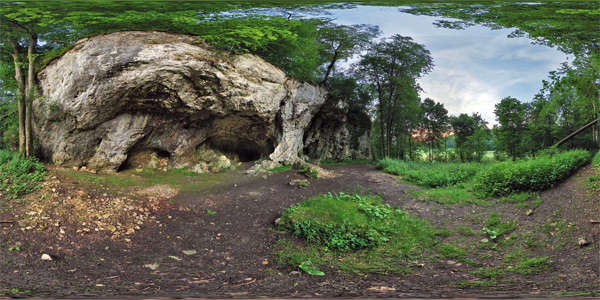
Panoramic view of Hohlenstein Stadel
The Hohlenstein (literally Hollow Rock) is not a cave, it is a limestone cliff at the southern rim of the Lonetal (Lone valley). It is hollowed by numerous small caves, hence the name. The caves are Hohlenstein-Stadel (barn), die kleine Scheuer (small barn) and the Bärenhöhle (Bear's Cave). Stadel and Bärenhöhle are true caves, the kleine Scheuer is just an overhanging cliff face, a type of shelter called abri by archaeologists. All three caves are important palaeontological and archaelogic locations. Like the other famous places along the Lonetal they were excavated in the second half of the 19th and the first half of the 20th century. Today the cave sediments are almost completely removed.
The first excavations were made by the former priest Oskar Fraas in the year 1861. He was in search for palaeologic remains, especially bear bones, and was very successful at the Bärenhöhle: he removed 88 skulls and more than 10 000 bone fragments. Because of this the formerly unnamed cave was dubbed Bärenhöhle (Bear's Cave). But although he had this enormous success, the excavation was pure vandalism. He concentrated on bear bones, but threw away anything else. Important archaeological sediments were dug out with shovels, the structure of the findings destroyed, anything but bear bones thrown on huge piles. He noticed this himself, during his second excavation in 1866, and moaned about the destruction he created. And this is one of the milestones of modern archaeology: when he learned that the thousands of flint pieces he found were remains of man. This was part of the discovery of the Stone Age.
The second excavation was pretty short. In 1939 the archaeologist Robert Wetzel from the Institut für Ur- und Frühgeschichte from Tübingen started his excavation, but soon World War II started and the excavation was quickly shut down. This is the reason why the most impressive finding of this excavation, a lionheaded figurine, was excavated but then stored in a cardboard box for decades and forgotten. After the war Robert Wetzel donated many of his finds, including many pieces of mammoth ivory, to the Ulm Museum. There they were again forgotten until 30 years after the discovery, when Joachim Hahn discovered the traces of carving on the small pieces. He reconstructed the headless body of the figure from more than 200 pieces.
Again 20 years later Elisabeth Schmid discovered more pieces of ivory, in the drawers of the museum, not in the cave, and completed the head.
Robert Wetzel returned to the Hohlenstein in 1954 and excavated the caves for several years. When he died rather young in 1961 the excavations ended again abruptly. But the findings of this excavation were spectacular. The femur, the thigh bone of a Neanderthal is one of only very few bones ever found of Neanderthals in southern Germany. The burial of three heads of people who suffered a violent death, a man, a woman, and a child, originates from the Mesolithic, about 9 000 BP. The so-called Knochentrümmerstätte (bone fragment sanctuary) was a pit at the cave entrance which contained more than 1 000 bone fragments of at least 54 individuals. It is dated to the Neolithic, about 6 000 BP. Today this is interpreted as secondary burial, the first theory about cannibalism is disproved by modern forensic methods. All those findings are shown in the Museum at Ulm.
Photo: © 2002-2012 kubische-panoramen.de
Text: http://www.showcaves.com/english/de/caves/Hohlenstein.html
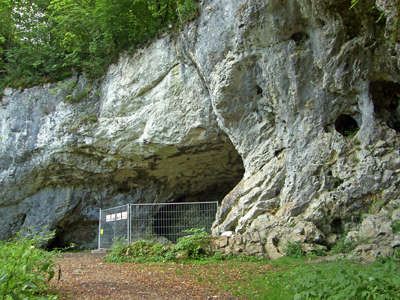
Forecourt of the Hohlenstein Stadel.
The Hohlenstein Stadel lies 3 metres higher than the Bärenhöhle, and is 69 metres deep. The cave has a wide entrance. The Lion Man was found here in 1939 by Otto Völzing. Important missing parts of the sculpture were only recently discovered, and the approximately 30 cm high figure is now being reconstructed. The stratigraphy reveals Magdalenian, Aurignacian (which contained the Lion Man) and 3 Middle Palaeolithic layers. A femur of Homo neanderthaliensis was found but it was most probably displaced by an animal.
Photo and text: Michael Hess 2012
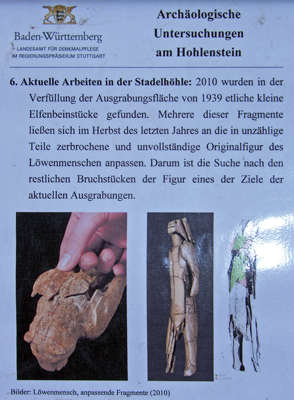
Sign on the metal grid which protects the cave from casual visitors.
The translation of the text reads -
Recent excavations in the Stadel cave:
In 2010 a number of small pieces of ivory were found in the backfill from the 1939 excavations. During autumn of that year it was possible to attribute a number of these fragments to their original place on the incomplete sculpture of the lion man that was shattered into numerous pieces. The purpose of the present excavations is to find the missing parts, for example the right arm, which would be wonderful to have.
Photo and text: Michael Hess 2012
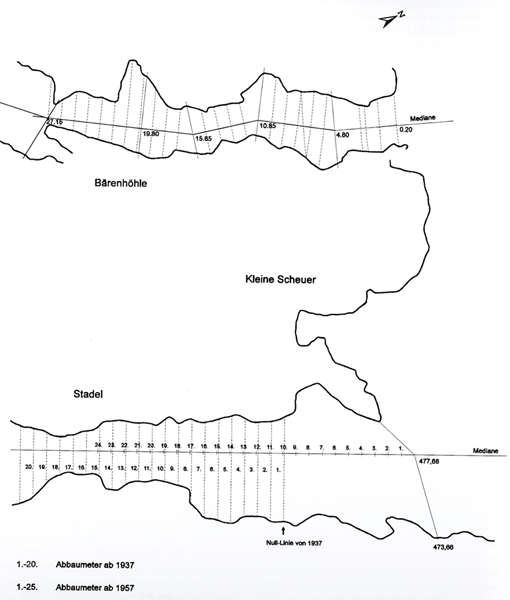
Plan showing the excavations of 1937 and 1957 in the Hohlenstein Stadel, as well as the plan of the neighbouring caves Abri kleine Scheuer and the Bärenhöhle.
Photo: Beck (1999)
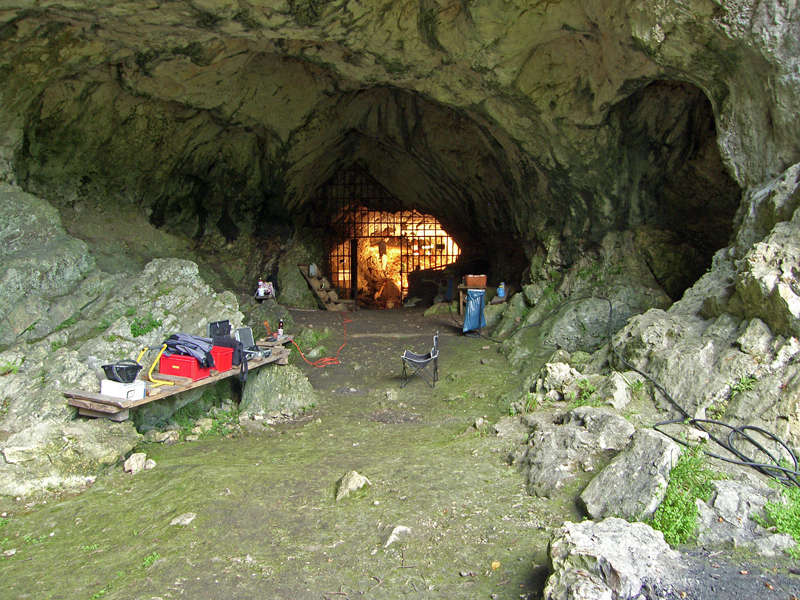
View into the Stadel with excavations in the rear part of the cave.
Photo and text: Michael Hess 2012
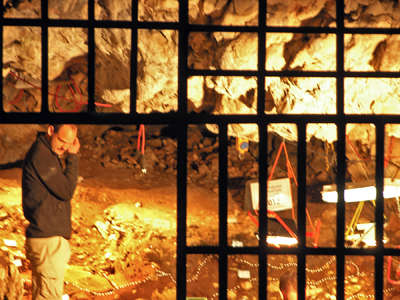
Close up of the gated area in the photograph above.
Hohlenstein Stadel. Excavation site where archaeologists are looking for missing parts of the Lion Man.
Photo and text: Michael Hess 2012
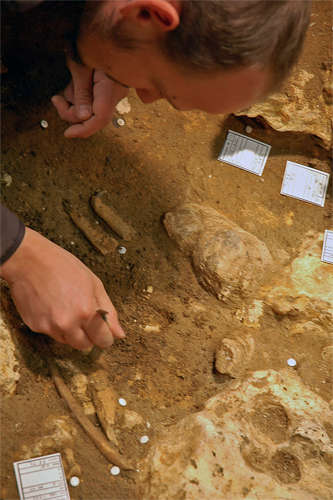
Excavations in the Stadel Cave.
Photo: http://www.denkmalpflege-bw.de/

Excavations in the Hohlensteistadel, 69 metres long, where the famous lion man/woman was found.
Photo: Holger Uwe Schmitt via Panoramio
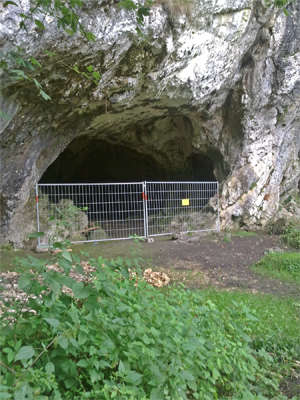
Hohlenstein Stadel.
The first excavations at Hohlenstein were made in the year 1861 by Oskar Fraas who was searching for bear bones. The finding of the Lion Man sculpture came on a later expedition in 1939 by archaeologist Robert Wetzel. However the excavation was stopped abruptly due to the outbreak of World War II, so the artifacts were collected and donated to the Museum of Ulm in Ulm, Germany.
It was not until decades later that a museum worker came across the archeological findings and assembled the pieces of the Lion Man. Robert Wetzel returned to Hohlenstein-Stadel in 1954 and continued excavating there until his death in 1961. Many pre-historic artefacts and Neanderthal remains were discovered.
Photo: Wikiman85
Permission: Public Domain
Text: Wikipedia
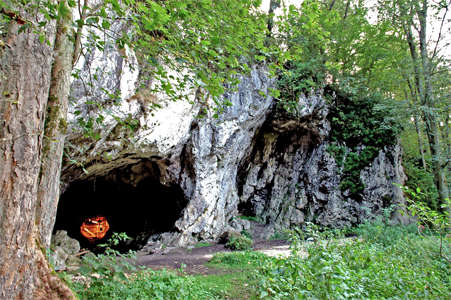
Hohlenstein Stadel.
Photo: http://www.denkmalpflege-bw.de/

Hohlenstein Stadel, kleine Scheuer, and the Bärenhöhle, from across the Lone.
Photo: http://www.denkmalpflege-bw.de/
View of the north to the Hohlenstein in the Lone Valley (municipality Asselfingen, Alb-Donau-Kreis).
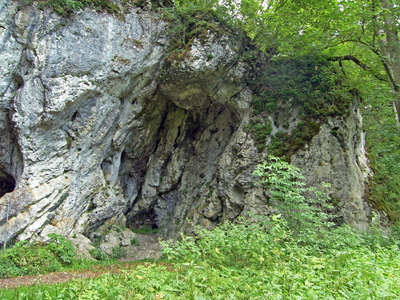
Abri 'kleine Scheuer', or small opening. The 'Stadel' opens to the left, the bear cave to the right about 3 metres lower.
The Abri kleine Scheuer is about 10 m wide and 8 m deep. It was the find spot for a pebble stone with typical Magdalenian lines of red dots.
Photo and text: Michael Hess 2012

View from the forecourt of the 'kleine Scheuer' towards the valley.
Photo and text: Michael Hess 2012

View of the Hohlenstein from the opposite side of the valley across the dry Lone stream. The access to the cave complex is between the car and the small hut to the right, both belonging to the excavation team.
Photo and text: Michael Hess 2012

Bärenhöhle (bear cave), the entrance to the Stadel is a few metres to the left.
The Bärenhöhle is 89 metres long, 2 metres above the level of the valley and opens to the North. The cave is a horizontal corridor with a large hall at the end. The name refers to the huge amounts of cavebear bones (89% of the findings, 88 skulls). The stratigraphy contains Magdalenien, Aurignacan, and Middle Paleolithic deposits
Photo and text: Michael Hess 2012
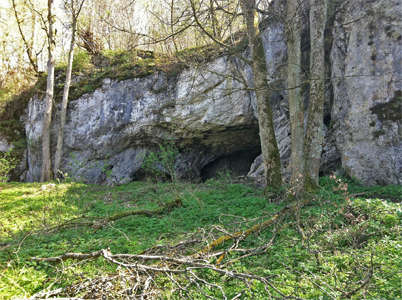
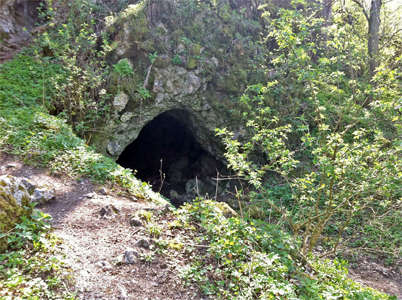
Bärenhöhle.
The Bärenhöhle is the westernmost cave in Hohlenstein. It is only 2 metres above the valley floor, and the north-facing triangular entrance is 6 metres wide and 4 metres high. The horizontal cave reaches a length of 60 metres. Inside, it consists of a 30 m long corridor with several lobes and a large hall at the end of the corridor.
Stratigraphy
Ia - Magdalenian
II - Aurignacian
III - Middle Palaeolithic
Photo: niko3518 via Panoramio
Text: Wikipedia
Cave bear humerus.
Ursus spelaeus
Pleistocene.
Bärenhöle im Hohlenstein, Lonetal near Asselfingen.
Photo: Don Hitchcock 2015
Source and text: Naturkunde Museum Stuttgart, State Museum of Natural History, Stuttgart
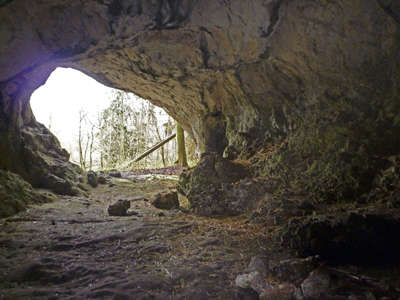
The Bärenhöhle from the inside looking out. This would have been a real refuge in times of bad weather. It was well lit, dry, protected from snow, rain and wind, and comparatively warm.
Most of the interesting material has been recovered from near the entry to the cave.
The animal remains found in the cave consisted of 98% cave bears . The numerous skulls and mandibles suggest a total count of several hundred individuals. Furthermore, the remains of wild horses, woolly mammoth, bison, elk, red deer and reindeer were found here.
Photo: Franzfoto
Permission: GNU Free Documentation License, Version 1.2
Text: Wikipedia
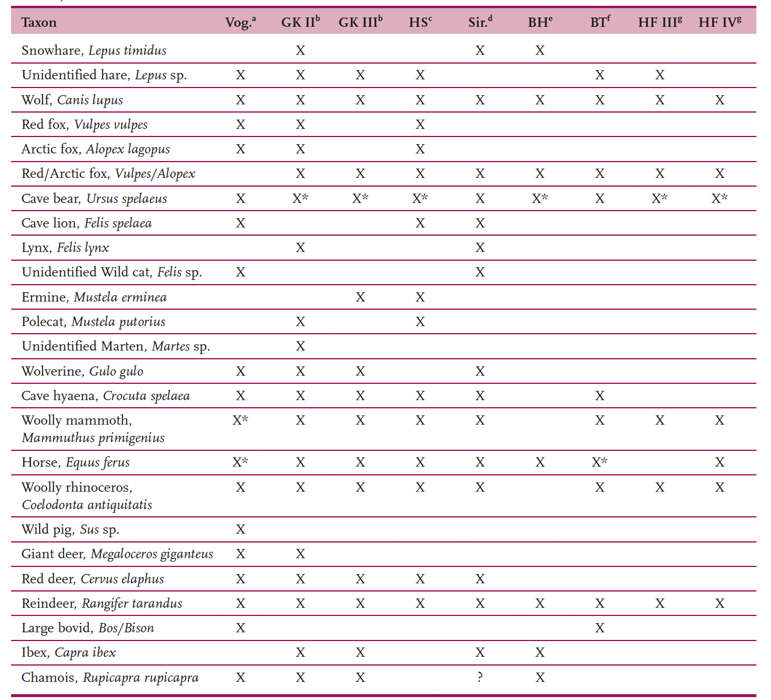
Summary of identified taxa (excluding avian, rodent taxa) from Aurignacian horizons, Swabian Jura, Germany. 'X' marks presence, 'X*' marks best-represented taxon, when available.
a Vog (Vogelherd, IV/V), Lehmann, 1954:115, Niven n.d.;
b GK (Geissenklösterle, AH II and AH III), Münzel, 1999;
c HS (Hohlenstein-Stadel IVa/IV), Gamble, 1979, p. 40, Table 4;
d Sir. (Sirgenstein, IV-VI), Schmidt, 1912;
e BH (Brillenhöhle, XIV), Boessneck and von den Driesch 1973);
f BT (Bockstein-Törle, VIII), Krönneck, personal communication;
g HF II, HF III (Hohle Fels), Conard et al., 2002.
Photo: Niven (2003)
Vogelherd
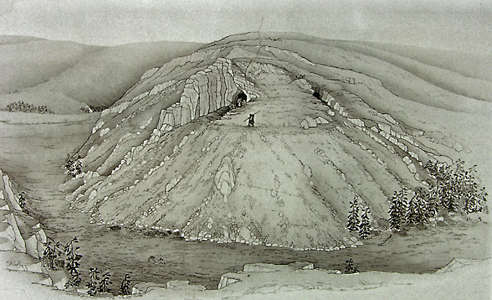
View of Vogelherd about 35 000 years BP. Note the glacial conditions, shown by the lack of trees apart from the normal gallery forest along the river where conditions are more conducive for plant life.
The Vogelherd cave is a karst cave formed by the ancient river, and lies exposed on a spur about 20 m above the present valley level with an excellent 180° view – a perfect observation spot. It has three entrances, one of which is blocked, with the other two connected by a 25 metre long corridor where two fireplaces were identified, as well as 11 small ivory statues – assumed to be the oldest (~40,000 BP) examples ever found.
They are of extraordinary artistic quality, some with decorations. The stratigraphy reveals deposits from the Neolithic, Magdalénien II, Magdalénien I, Aurignacian II, Aurignacian I, late Middle Paleolithic, Mousterian, and the Micoquien, with the floor level assumed to be the Eemian (also Sangamonian, Ipswichian, Mikulin, Valdivia, Riss-Würm) interglacial.
Photo and text: Michael Hess 2012
Source: Sign near the Vogelherd site.
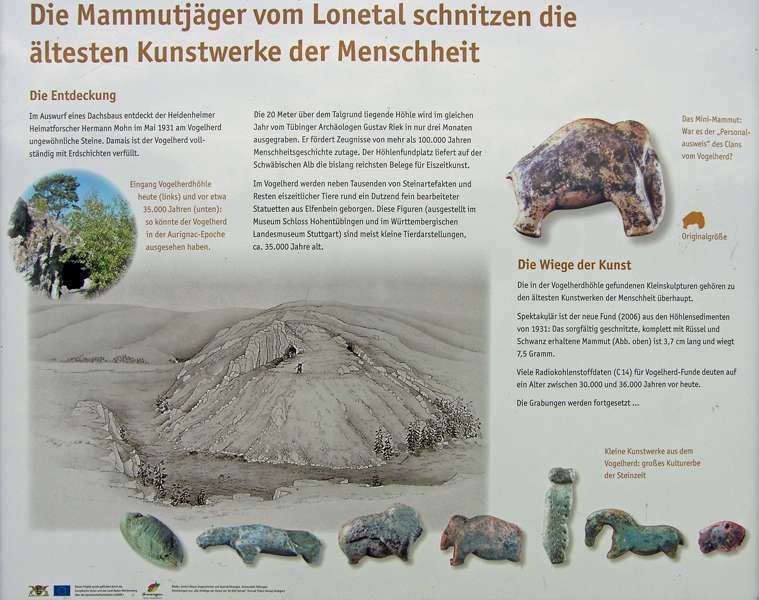
The sign shows the view about 35 000 years BP and a selection of photos of the figurines that were found in the cave opposite the Southwest entrance.
Translation: The mammoth hunters of the Lone valley carved the oldest known sculptures – figurative pieces of art – most of them animals. The material dug out by a badger contained unusually shaped stones that arose the interest of Herrmann Mohn in 1931. At that time, the cave was completely filled with gravel, stones, and layers of earth. In the same year the area was excavated by Gustav Riek, an archaeologist from the University of Tübingen – the same university, by the way, that has conducted excavations at Troy since 1988 (Manfred Korff and Ernst Pernicka).
Artefacts as old as 100 000 BP were discovered, and the cave site on the Swabian Alb proved to be the richest source for the oldest pieces of Ice-age art. Besides thousands of stone artefacts and remains of ice-age fauna about a dozen finely made sculptures – mostly animals – were found. They are on exhibition in the Württembergisches Landesmuseum, Stuttgart, in the Museum Schloss Hohentübingen, Tübingen, in the Museum of Ulm and in the recently opened Archeological Park next to the Vogelherd site.
Photo and text: Michael Hess 2012
Source: Display near the Vogelherd site.

Plan of the Vogelherd Cave system.
Information board for the Vogelherd cave.
Translation:
'From the hunters' point of view the venue of the cave is a perfect position. The platform above the cave is a perfect lookout, almost 180°. The cave has 3 entrances, to the North (blocked), to the South, and to the South-West. The 25 metre long galleries – starting at the entrances - meet inside the cave forming an approximately Y-shaped pattern.
Schlagplatz: where silex tools were shaped
Höhlenvorplatz: forecourt
Elfenbeinbearbeitung: ivory working
Feuerstelle: fire place
Mammutknochen: mammoth bones
Knochenampel: bone lamp
Schlagsteine: hammer stones
Gerätefassungen: tool frames; ivory figures
Kratzer: scrapers
Lochstäbe: perforated batôns, 'batôns de commandment'
Mammutstoßzahnstücke: mammoth tusk fragments.
Now, we are going to walk through the cave starting at the Southwest entrance towards the South entrance and turn around.
Photo and text: Michael Hess 2012
Source: Display near the Vogelherd site.
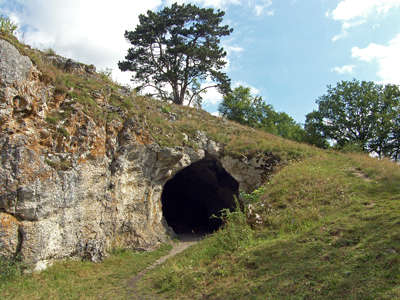
Southwest entrance of the Vogelherd, view at the forecourt. Left of the entrance where the cliff wall goes down to the ground marks the site where flint tools were shaped. Mammoth bones were found left of the entrance.
Photo and text: Michael Hess 2012

The ivory working site is to the far right, close to the entrance that lies behind. The find spot of the batons is right at the corner to the right. The 11 ivory animal figurines were found dead ahead near the small protruding part of the wall. The hearth was about 5 metres to the right, where the wall recedes slightly. The north exit was to the left but is blocked.
Photo and text: Michael Hess 2012
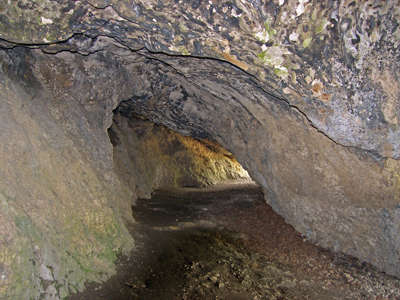
View from the site where the ivory figurines were found towards the south entrance.
The hearth was in front where the wall recedes. The batons were found to the right.
Photo and text: Michael Hess 2012
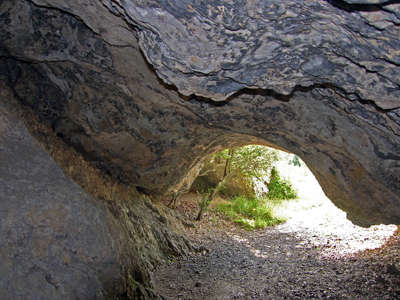
The southern entrance, the mammoth tusk fragments were found in the middle of the entrance.
Photo and text: Michael Hess 2012
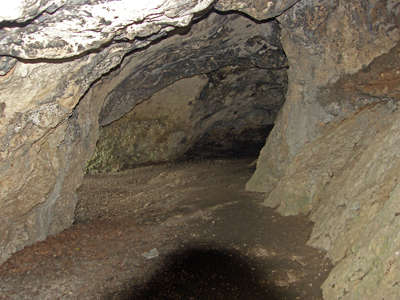
View back from the south entrance towards the southwest entrance to the left and the blocked north entrance to the right. Near this site was the hearth, and the ivory figurines were found straight ahead in front of the protruding wall.
Photo and text: Michael Hess 2012

The southern entrance from the outside.
Photo and text: Michael Hess 2012
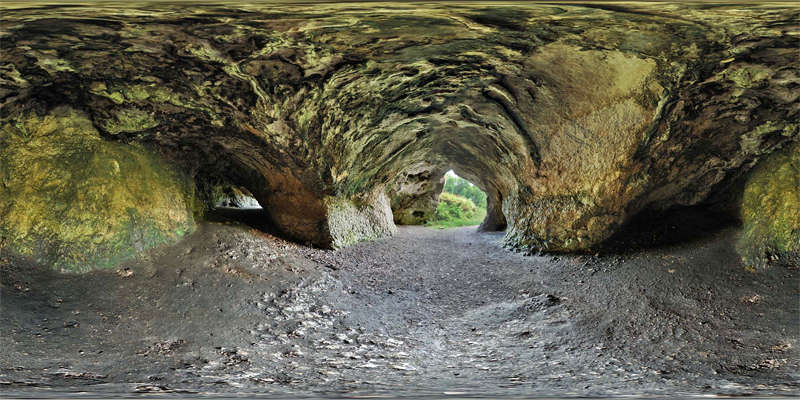
Panorama of the Vogelherd cave from within.
Photo: © 2002-2012 kubische-panoramen.de
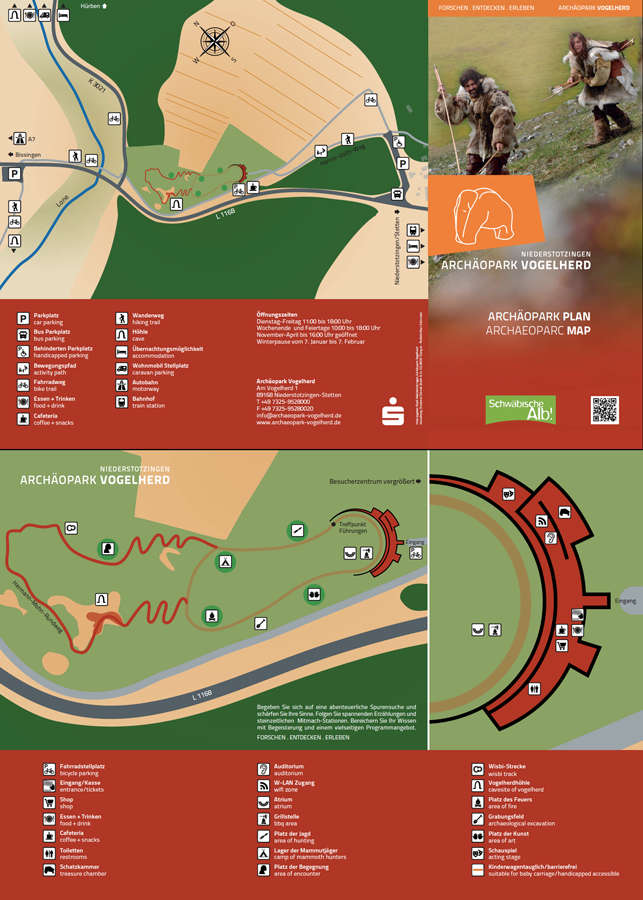
There is an Archaeopark with an interpretation centre for the Vogelherd area, and guided tours are available.
Photo: http://www.archaeopark-vogelherd.de/
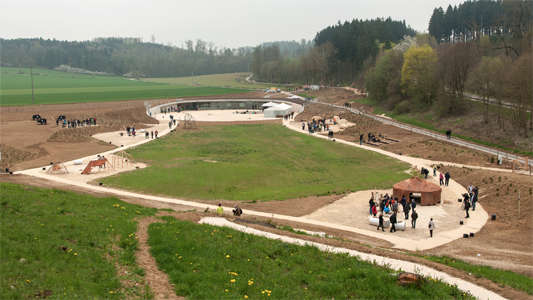
The Archaeopark appears to have a permanent well constructed undercover display area, as well as outside areas for visitors to try their hand at throwing a spear at a target with an atlatl, and areas where various temporary displays are set up, as well as semi-permanent displays of the type of dwellings which may have been constructed during the ice ages, such as the round framed tent covered with skins similar to that proposed elsewhere for Gönnersdorf, lower right.
Photo: Thilo Parg
Permission: Creative Commons Attribution-Share Alike 3.0 Unported license.
Summary of faunal remains from the Aurignacian at Vogelherd,
expressed as NIS (number of identified specimens) and MNI (minimum number of individuals)
| Taxon | Common Name | NIS | MNI |
|---|---|---|---|
| Canis lupus | Wolf | 38 | 7 |
| Crocuta spelaea | Cave Hyena | 17 | 2 |
| Vulpes/Alopex | Fox | 20 | 7 |
| Ursus spelaeus | Cave Bear | 120 | 8 |
| Ursus arctos | Brown Bear | 2 | 1 |
| Panthera leo spelaea | Cave Lion | 4 | 2 |
| Felis silvestris | Wild Cat | 3 | 2 |
| Gulo gulo | Wolverine | 1 | 1 |
| Coelodonta antiquitatis | Wooly Rhino | 124 | 12 |
| Mammuthus primigenius | Wooly Mammoth | 3540 | 28 |
| Equus ferus | Horse | 1423 | 27 |
| Cervus elaphus | Red Deer | 19 | 3 |
| Rangifer tarandus | Reindeer | 1633 | 28 |
| Bos/Bison | Aurochs/Bison | 61 | 6 |
| Sus scrofa | Boar | 8 | 1 |
| Rupicapra rupicapra | Chamois | 2 | 1 |
| Lepus sp. | Hare | 27 | 3 |
| Birds | Various Taxa | 13 | 8 |
| Totals | 7055 | 147 |
In the Aurignacian faunal assemblage overall, just 4% of the specimens exhibit carnivore tooth marks. In regard to the main subsistence taxa (reindeer and horse), the tooth-marked numbers are 2.4% and 9.8%, respectively. These frequencies are significantly lower than those found in bone assemblages attributed solely to carnivores, which range from 57% to 83% on various portions of the long bones (Marean et al., 2000). Both experimental and fossil faunas modified by humans and subsequently by carnivore scavengers exhibit tooth mark frequencies between 7% and 19% (Marean et al., 2000). Only one horse specimen shows both a cut and tooth mark. (Niven, 2007)
It has been argued (Niven, 2001, 2006) that Wooly Mammoth were probably not hunted by the Aurignacian people at Vogelherd, but instead their remains were collected from natural deaths, and in the case of the numerous infant individuals, brought to the cave by carnivores. Support for the infant mammoths as carnivore prey is found in tooth marks on many specimens; the same evidence is abundant on the infant rhinoceros remains. Late Pleistocene hyenas were capable of hunting young mammoths of up to 700 Kg in size (Lister, 2001); these animals, as well as rhinoceros infants, would have been well in the range of hunting capability of wolf and lion, if we consider the predatory behaviours of their extant counterparts (Mech, 1970, Owen-Smith, 1988)
(Thus we can deduce that the vast majority of the animal bones found at Vogelherd were there as a result of human transport to the cave, and in the case of the Reindeer and Horse, as a result of human hunting and/or trapping of the animals. From the numbers in the table above, the preferred prey of the inhabitants of Vogelherd were the Wooly Mammoth, the Reindeer, and the Horse, with the Mammoth being brought back to the cave when found dead or dying. From the number of mammoth sculptures, they were an important part of their folk lore, were a wonderful source of meat, fat, bone, and ivory, and no doubt the hunters wished they could actively hunt the mammoth rather than relying on chance finds. One wonders why they never worked out methods that worked well, as later humans did - Don )
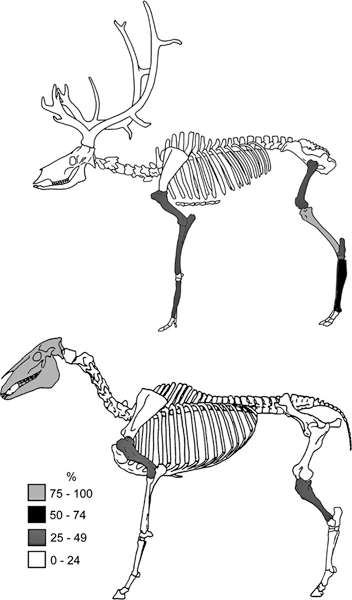
Standardised values of minimum animal units (% MAU) for reindeer and horse. Reindeer antler excluded.
Various lines of evidence indicate that Aurignacian groups procured these taxa regularly during late summer and fall; in the case of reindeer, timing of hunts correlates with their migration. In addition, people invested considerable time and labor to intensively exploit reindeer and horse for fat in addition to meat protein in a consistent fashion over many millennia at this site. Subsistence- related behaviours include: (1) thorough processing of selected carcass portions and (2) emphasising the extraction of various macronutritional products beyond that predicted by standard energetic values, including lipids from animal fat.
Photo and text: Niven (2007)

Fig. 5. Mortality profiles of reindeer (a) and horse (b).
(MNE = minimum number of elements)
Reindeer MNE data by age: < 1 year (2); 1- 2 years (1); 2 - 3 years (1);
3 - 5 years (9); 6 - 9 years (7); > 9 years (1).
Horse MNE data by age: 0 - 2 years (10); 3 - 4 years (22); 5 - 6 years (3); 7 - 8 years (7);
9 - 10 years (26); 11 - 12 years (21); 13 - 14 years (23); > 14 years (16).
Based on ethological information on reindeer and horse, it is reasonable to assume that these animals were locally abundant during certain seasons. Their movements would have covered areas between the steppe plateau to the north of the valley and the flatlands to the south, close to the Danube.
Based on reindeer migratory behavior, we might predict that their migrations followed ridgelines in the hills to the north of Vogelherd and along rivers. Family groups of horses, which are indicated in the Vogelherd assemblage, normally remain in small home ranges with limited movements between feeding areas and water sources.
The vantage point from Vogelherd likely facilitated locating the seasonally predictable and aggregated reindeer and horse herds. Evidence for site occupation at other times of the year is lacking and, in fact, one deciduous tooth of a large bovid also indicates a late summer-fall season of death. Other factors presumably influenced the seasonally specific occupations of Vogelherd, though the faunal data show that local predictability of prey was a prominent one.
Photo and text: Niven (2007)
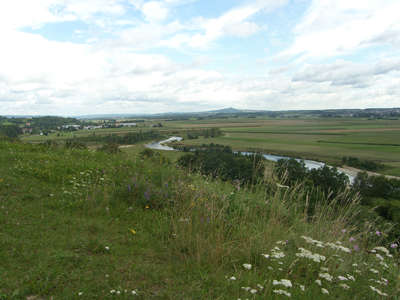
There is no reason that reindeer could not have crossed the Donau (Danube) as part of their migration. This photograph of the Donau not all that far from the Lonetal, a little upstream of Ulm near Hunsingen shows that it could easily be forded in many places, before the Donau was dammed at regular intervals for electricity production.
Photo: Michael Hess 2012
Anticipated reuse of the cave is seen in several aspects of the artefact assemblages. The unworked ivory raw material and the bundle of unfinished ivory rods suggest caching of these items for future artefact manufacture. The presumed caches of unused flakes, scrapers, blades, and cores, as well as the supplies of mammoth bone for fuel and/or building, would have served as insurance gear, and they imply logistical planning for future visits. As argued above, these occupations were on a seasonal basis.
Text: Niven (2007)
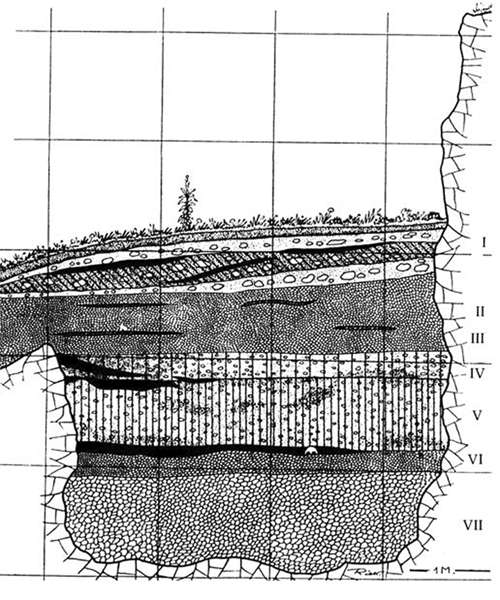
Vogelherd cave stratigraphy (Profile 1) showing location of Stetten cranium (Homo sapiens sapiens) at the bottom of Aurignacian layer V
Adapted from Riek (1934):41, Abb. 3.
Photo and text: Niven (2003)
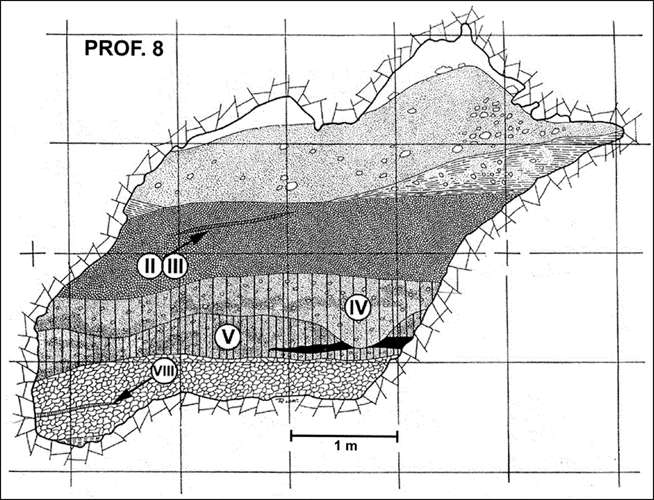
Profile 8 from Vogelherd. Archaeological strata marked with Riek's numbering system and arrows.
Adapted from Riek (1934):45, Abb. 5.
Photo and text: Conard et al. (2003)
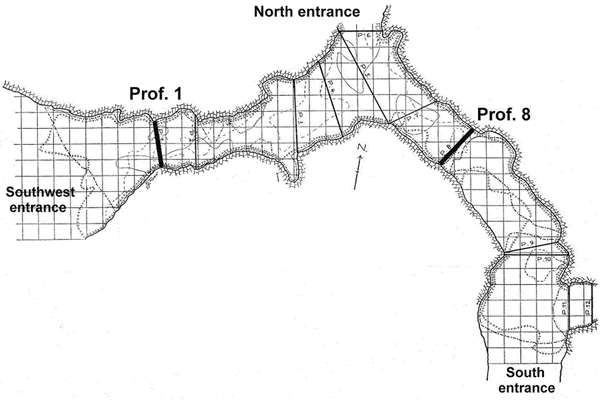
Ground plan of Vogelherd, showing locations of Profiles 1 and 8.
Adapted from Riek (1934):11, Abb. 2.
Photo and text: Conard et al. (2003)
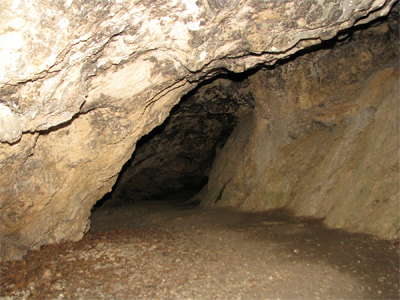
Interior of Vogelherd.
Photo: Michael Fiegle, 25th October 2011
Permission: This file is licensed under the Creative Commons license Attribution-Noncommercial-Share Alike 3.0 Unported license.
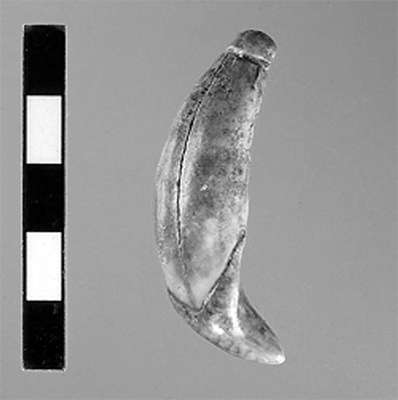
Incised brown bear (Ursus arctos) canine from Vogelherd, archaeological horizon unknown.
Specimen AMS dated to 29 620 ± 210 BP.
(The groove or rainurage at the top of the tooth was used to attach a cord to the tooth to use it as a pendant - Don )
Photo: Hilde Jensen
Text: Conard et al. (2003)
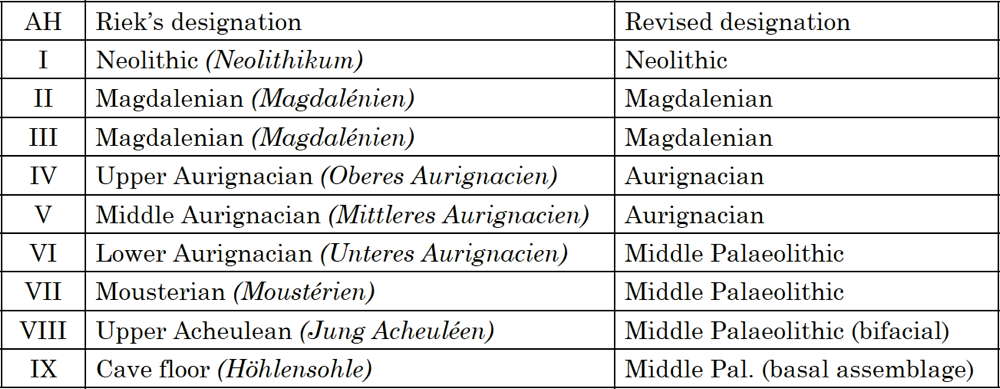
Cultural horizons of Vogelherd: left column lists Riek's original designations, right column lists the revised layer designations.
Photo: Conard et al. (2003)
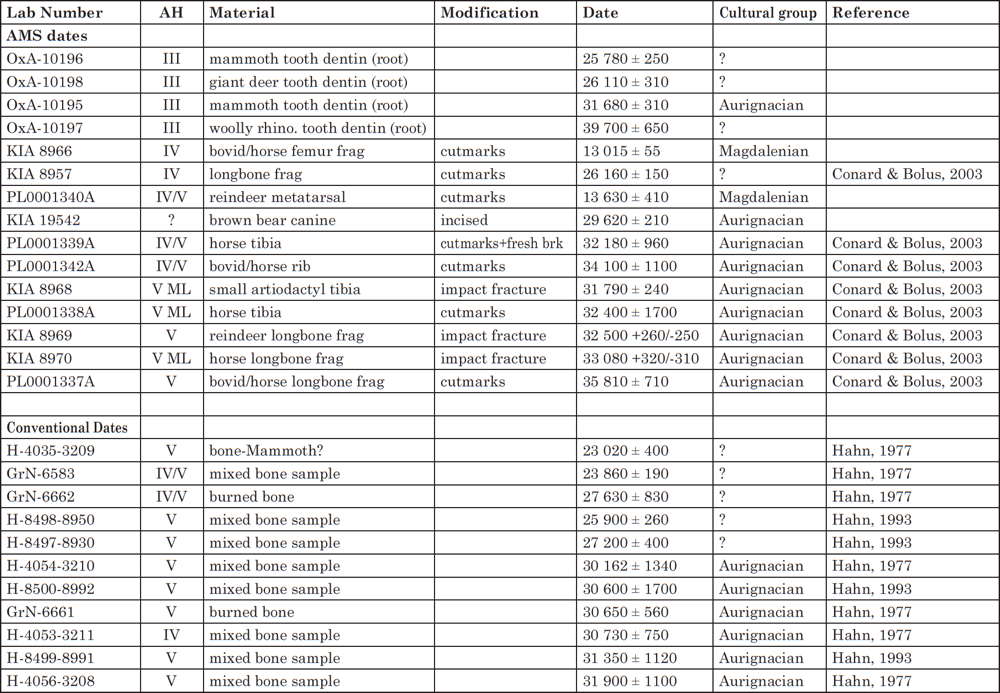
Comprehensive summary of AMS (top) and conventional (bottom) radiocarbon dates from Vogelherd.
Photo: Conard et al. (2003)
Note that AMS (Accelerator Mass Spectrometry) radiocarbon dating is a way to obtain radiocarbon dates from samples that are far tinier than that needed for standard radiocarbon dating. Standard 14C dates require amounts of between 1 and 10 grams of charcoal; AMS can use as little as 1-2 milligrams, and under special circumstances to samples as small as 50-100 micrograms.
Text above from http://archaeology.about.com/od/amthroughanterms/g/ams_radiocarbon.htm
References
- Beck D., 1999: Das Mittelpaläolithikum des Hohlenstein, Habelt
- Bürger L. , 1892: Der Bockstein, das Fohlenhaus, der Salzbühl, drei prähistorische Wohnstätten im Lonetal, Mitteilungen des Vereins für Kunst und Altertum in Ulm und Oberschwaben 3.
- Conard, N., Niven L., Mueller K., Stuart A., 2003: The Chronostratigraphy of the Upper Paleolithic Deposits at Vogelherd, Mitteilungen der Gesellschaft für Urgeschichte, — 12 (2003) 73
- Conard N., Richter J., 2011: Neanderthal Lifeways, Subsistence and Technology: One Hundred Fifty Years of Neanderthal Study, (Google eBook), Springer, 2011, XV, 293p.
- Krönneck P., Niven L., Uerpmann H., 2004: Middle Palaeolithic Subsistence in the LoneValley (Swabian Alb, Southern Germany), Int. J. Osteoarchaeol., . 14: 212–224 (2004)
- Lehmann U., 1960: Paläontologische Forschung im Lone- und Brenztal., Jahreshefte für Karst und Höhlenkunde, 1: 105–117.
- Lister A., 2001: Age profile of mammoths in a late Pleistocene hyaena den at Kent’s Cavern, Devon, England. In: West, D. (Ed.), Proceedings of the International Conference on Mammoth Site Studies, University of Kansas Publications in Anthropology 22, Lawrence, pp. 35-43.
- Marean, C., Abe, Y., Frey, C., Randall, R., 2000: Zooarchaeological and taphonomical analysis of the Die Kelders Cave 1 layers 10 and 11 Middle Stone Age larger mammal fauna., J. Hum. Evol., 38, 197-233.
- Mech, L., 1970: The Wolf: The Ecology and Behavior of an Endangered Species, University of Minnesota Press, Minneapolis.
- Niven L., 2001: Patterns of subsistence and settlement during the Aurignacian of the Swabian Jura, Germany, In: Cavarretta, G., Gioia, P., Mussi, M., Palombo, M. (Eds), La Terra Degli Elefantid, The World of Elephants: Proceedings of the 1st International Congress CNR, Rome, pp. 323-327.
- Niven L., 2003: The role of mammoths in Upper Palaeolithic economies of southern Germany, In: J. Zilhão, F. d’Errico (Eds), The Chronology of the Aurignacian and of the Transitional Technocomplexes: Dating, Stratigraphies, Cultural Implications.Trabalhos de Arqueologia 33: 199-211.
- Niven L., 2006: The Palaeolithic Occupation of Vogelherd Cave: Implications for the Subsistence Behavior of Late Neanderthals and Early Modern Humans. Kerns Verlag, Tübingen.
- Niven L., 2007: From carcass to cave: Large mammal exploitation during the Aurignacian at Vogelherd, Germany, Journal of Human Evolution, 53 (2007) 362-382.
- Owen-Smith R., 1988: Megaherbivores: The Influence of Very Large Body Size on Ecology, Cambridge University Press, Cambridge.
- Riek, G., 1934: Die Eiszeitjägerstation am Vogelherd im Lontal, Tübingen: Akademische Buchhandlung Franz F. Heine.
- Wehrberger K., 2000: . 'Der Streit ward definitiv beendet . . . 'Eine Mesolithische Bestattung aus der Bocksteinhöhle im Lonetal, Alb-Donau-Kreis., Archaölogisches Korrespondenzblatt, 30: 15–31.
- Wetzel R., 1954: Quartärforschung im Lonetal, Eiszeitalter und Gegenwart, 4/5: 106–141.
- Wetzel R., 1958: Die Bocksteinschmiede mit dem Bocksteinloch, der Brandplatte und dem Abhang sowie der Bocksteingrotte, Teil 1, W. Kohlhammer: Stuttgart.
- Wetzel R., 1967: Der Hohlenstein im Lonetal, Mitteilungen des Vereins für Naturwissenschaften und Mathematik in Ulm, 26: 21–75.
- Wetzel R., Bosinski G., 1969: Die Bocksteinschmiede im Lonetal (Markung Rammingen, Kr. Ulm), Teil I., Müller & Gräff: Stuttgart.
Back to Don's Maps
 Back to Archaeological Sites
Back to Archaeological Sites
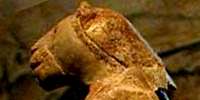 Lowenfrau, Löwenmensch, the Lion Lady Venus - carved from mammoth ivory, it is 28 cm high and 6 cm in diameter. It was found in the Stadelhöhle am Hohenstein, a rocky cliff in the Lonetal valley above Asselfingen, Baden-Wurttemberg (Germany), in 1931, dated as Aurignacian, in a 32 000 year old level. Although this is known in some places as the lion lady, it is now known to be male. The arms bear striations carved into the ivory. It is pieced together from more than 200 tiny pieces. This 'venus' may be an attempt to capture the power of the lion.
Lowenfrau, Löwenmensch, the Lion Lady Venus - carved from mammoth ivory, it is 28 cm high and 6 cm in diameter. It was found in the Stadelhöhle am Hohenstein, a rocky cliff in the Lonetal valley above Asselfingen, Baden-Wurttemberg (Germany), in 1931, dated as Aurignacian, in a 32 000 year old level. Although this is known in some places as the lion lady, it is now known to be male. The arms bear striations carved into the ivory. It is pieced together from more than 200 tiny pieces. This 'venus' may be an attempt to capture the power of the lion.

